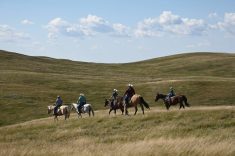I like to joke that ranching is a marathon, except when it is a sprint, and then it’s that too.
There are certainly times when you are racing from one urgent task to another. While it feels like the rest of the working world has three to five business days to respond to a request, that tactic doesn’t apply when cattle escape onto a busy road, the stock water dries up or a sick animal needs attention.
The fall run is a good reminder of the contrast between the long wait and the mad dash intrinsic to cow-calf production. It’s a time of gathering, sorting, shipping, evaluating and selecting. There is a familiar rhythm of activities like weaning and preg-checking that yield easy-to-count metrics producers use to inform decisions or (more honestly) take pride in. Are the weaning weights up or down? Did the cows breed early? Are we happy with how the calves looked out of that new herd bull?
Read Also

Managing through market or individual stock declines
Even the best of public-traded companies can periodically experience significant drawdowns, and a successful investor should be prepared to react — or not react — accordingly, Herman VanGenderen writes.
For insightful observers, the season can also underline subtleties that pull at the heartstrings of the gruffest, toughest cattle producer. Maybe it’s a set of twins that thrived despite the odds, or a favourite, reliable cow that raised one last calf before it’s time for her to go down the road.
There are things about raising a live animal commodity that are inherently different from other agricultural sectors. Planting, harvesting and marketing a cash crop within six months requires a different approach than the mindset necessary for operating within the messy, complex continuum of breeding, grazing, weaning and calving.

The fall is often an incredibly important time for beef businesses. For many commercial cattle producers, this period is where a big portion of annual income is generated. Managing cash flow and budgeting on a single big paycheck for the year is challenging, even when prices are good. Producers who have retained calves to feed or breed have a minimum of 12 to 24 months of expenses tied up in a live critter that has yet to leave the farm. There are a lot of moving parts between conception to market that impact profit.
While most producers are strategic about paying their bills, there isn’t a Magic 8 Ball with answers on how to parse out those funds so they last until the following year or beyond. Will the winter be tough or the summer dry? Should we invest in water? Land? Buy more cattle? Pay down debt? Should more calves be sold when prices are good? Or should females be kept to increase the breeding herd? It’s impossible to anticipate all the chances, choices, and outcomes.
Yes, raising cattle can be fast-paced and full of life-or-death moments, and that’s likely part of what makes this business appealing for some. But an equally important aspect of raising cattle is about pacing oneself to make it to the finish line, or more practically, the next payday.
For cattle producers, the fall is the end of a chapter, a new beginning, and a continuing saga, all at once. Be patient yet quick, sprint but also walk, and acknowledge the risks you take on for a business that somehow costs and pays you more than you can define.















